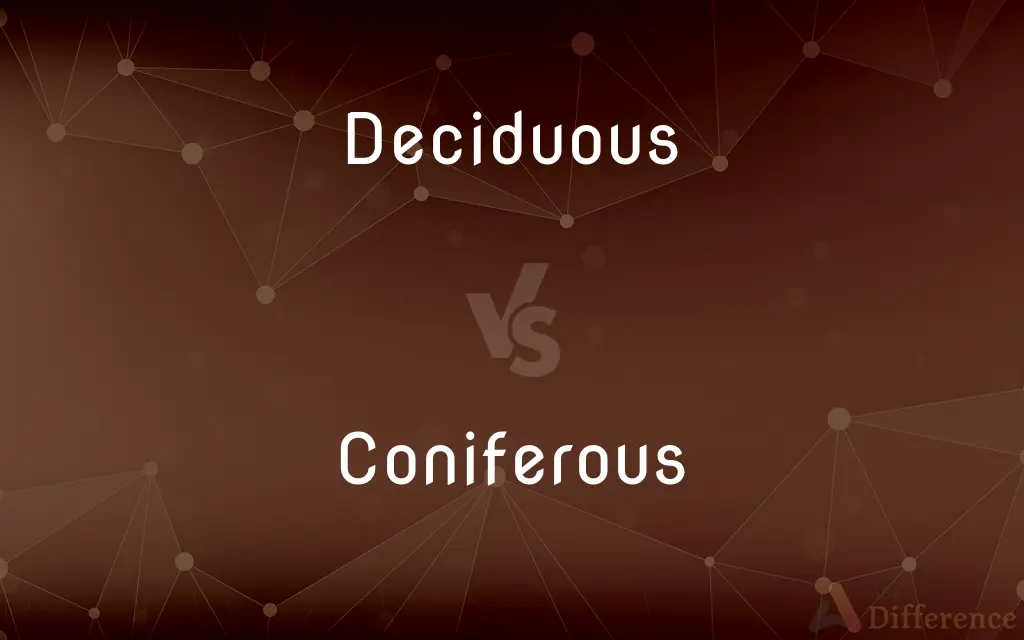Deciduous vs. Coniferous — What's the Difference?
Edited by Tayyaba Rehman — By Fiza Rafique — Updated on April 17, 2024
Deciduous trees shed their leaves annually, adapting to seasonal changes, while coniferous trees maintain their needles year-round, suited for colder climates.

Difference Between Deciduous and Coniferous
Table of Contents
ADVERTISEMENT
Key Differences
Deciduous trees are known for their broad leaves that they shed each fall, marking a distinct adaptation to temperate zones that experience varied seasonal climates. On the other hand, coniferous trees retain their needle-like leaves throughout the year, which is an adaptation to colder and sometimes harsher environments.
The leaf structure in deciduous trees is typically broad and flat, which maximizes photosynthesis during the warm months but becomes a liability in winter, leading to their shedding. Whereas, coniferous trees have narrow, needle-like leaves with a waxy coating that reduces water loss, making them well-suited for retaining moisture and surviving in less fertile conditions.
Deciduous forests are often rich in biodiversity, supporting a wide range of wildlife and plant species due to the seasonal cycles that affect food availability and habitat structures. In contrast, coniferous forests, while less diverse, support a hardy set of species that can endure the long, cold winters and nutrient-poor soils typical of such ecosystems.
Seasonally, deciduous trees offer a visual spectacle, changing colors dramatically before losing their leaves. Coniferous trees, however, provide a constant green backdrop, which is crucial in landscapes that receive heavy snowfall, as they help to reduce soil erosion throughout the year.
Culturally and economically, deciduous trees have been central in many traditions, including agriculture and hardwood timber production, due to their broad, strong wood. Coniferous trees are economically vital as well, primarily for their softwood timber, which is essential in construction and paper manufacturing.
ADVERTISEMENT
Comparison Chart
Leaf Type
Broad, flat
Narrow, needle-like
Leaf Retention
Shed annually
Retained year-round
Climate Adaptation
Temperate zones
Colder, harsher climates
Biodiversity
High biodiversity
Lower biodiversity
Economic Use
Hardwood timber, agriculture
Softwood timber, construction
Compare with Definitions
Deciduous
Trees that lose their leaves annually.
The maple, a deciduous tree, dazzles with its autumn colors.
Coniferous
Trees that retain their needles all year.
Pine trees are a common type of coniferous tree.
Deciduous
Relating to the temporary nature of attachment.
The garden's deciduous shrubs need replanting every spring.
Coniferous
Characterized by needle-like leaves.
Coniferous forests are dense with evergreen foliage.
Deciduous
Found primarily in temperate zones.
Deciduous trees are prevalent in areas with four distinct seasons.
Coniferous
Adapted to cold, sometimes arid climates.
Coniferous trees dominate the high northern latitudes.
Deciduous
Supports diverse ecosystems.
Deciduous trees contribute to the habitat's biodiversity with their seasonal changes.
Coniferous
Often used for softwood lumber.
Coniferous wood is preferred for its ease of handling and construction.
Deciduous
Characterized by seasonal leaf shedding.
Deciduous forests turn bare in the winter months.
Coniferous
Less diverse but resilient ecosystems.
Coniferous forests support wildlife adapted to cold conditions.
Deciduous
In the fields of horticulture and botany, the term deciduous (; US: ) means "falling off at maturity" and "tending to fall off", in reference to trees and shrubs that seasonally shed leaves, usually in the autumn; to the shedding of petals, after flowering; and to the shedding of ripe fruit. The antonym of deciduous in the botanical sense is evergreen.
Coniferous
Any of various mostly needle-leaved or scale-leaved, chiefly evergreen, cone-bearing gymnospermous trees or shrubs of the order Coniferales, such as pines, spruces, and firs.
Deciduous
Shedding or losing foliage at the end of the growing season:deciduous trees.
Coniferous
Bearing cones, as the pine and cypress.
Deciduous
Falling off or shed at a specific season or stage of growth:deciduous antlers; deciduous leaves.
Coniferous
Of, or pertaining to, a conifer.
Deciduous
Of or relating to the primary teeth.
Coniferous
Bearing cones, as the pine and cypress.
Deciduous
Describing a part that falls off, or is shed, at a particular time or stage of development.
Coniferous
Of or relating to or part of trees or shrubs bearing cones and evergreen leaves
Deciduous
(botany) Of or pertaining to trees which lose their leaves in winter or the dry season.
A deciduous tree
Deciduous
Transitory, ephemeral, not lasting.
Deciduous
Falling off, or subject to fall or be shed, at a certain season, or a certain stage or interval of growth, as leaves (except of evergreens) in autumn, or as parts of animals, such as hair, teeth, antlers, etc.; also, shedding leaves or parts at certain seasons, stages, or intervals; as, deciduous trees; the deciduous membrane.
Deciduous
(of plants and shrubs) shedding foliage at the end of the growing season
Deciduous
(of teeth, antlers, etc.) being shed at the end of a period of growth;
Deciduous teeth
Common Curiosities
Why do deciduous trees shed their leaves?
Deciduous trees shed their leaves to conserve water and reduce energy expenditure during unfavorable seasons.
What defines a deciduous tree?
Deciduous trees are defined by their annual leaf shedding, primarily in response to cold or dry seasons.
What defines a coniferous tree?
Coniferous trees are defined by their year-round retention of needle-like leaves.
How do coniferous trees adapt to cold climates?
Coniferous trees adapt through their needle-like leaves which reduce water loss and a waxy coating that protects against freezing.
Can deciduous trees grow in cold climates?
While deciduous trees are more common in temperate zones, some varieties can withstand colder climates.
What are the ecological benefits of coniferous trees?
Coniferous trees help stabilize soils and provide year-round habitats for certain wildlife species.
What kind of wildlife relies on deciduous forests?
A wide range of animals, including various birds, mammals, and insects, rely on deciduous forests for food and shelter.
How do the leaves of deciduous trees differ from coniferous trees?
Deciduous trees have broad, flat leaves that are shed seasonally, while coniferous trees have narrow, hardy needles.
What are the ecological benefits of deciduous trees?
Deciduous trees support high biodiversity due to their nutrient-rich leaf litter and seasonal habitat changes.
What is the life span of deciduous trees compared to coniferous?
Deciduous trees often have shorter lifespans compared to many coniferous species, which can live for centuries.
Are coniferous trees evergreen?
Yes, most coniferous trees are evergreen, retaining their leaves throughout the year.
Are there any deciduous conifers?
Yes, a few species like the larch are deciduous conifers, shedding their needles annually.
What kind of wildlife relies on coniferous forests?
Species that can endure harsh climates, like the snowshoe hare and lynx, thrive in coniferous forests.
How are deciduous trees used by humans?
Deciduous trees are often used for furniture, tools, and as ornamental trees due to their broad, strong wood.
How are coniferous trees used by humans?
Coniferous trees are primarily used for paper production and building materials due to their soft, workable wood.
Share Your Discovery

Previous Comparison
Phrase vs. Idiom
Next Comparison
Act vs. LawAuthor Spotlight
Written by
Fiza RafiqueFiza Rafique is a skilled content writer at AskDifference.com, where she meticulously refines and enhances written pieces. Drawing from her vast editorial expertise, Fiza ensures clarity, accuracy, and precision in every article. Passionate about language, she continually seeks to elevate the quality of content for readers worldwide.
Edited by
Tayyaba RehmanTayyaba Rehman is a distinguished writer, currently serving as a primary contributor to askdifference.com. As a researcher in semantics and etymology, Tayyaba's passion for the complexity of languages and their distinctions has found a perfect home on the platform. Tayyaba delves into the intricacies of language, distinguishing between commonly confused words and phrases, thereby providing clarity for readers worldwide.















































